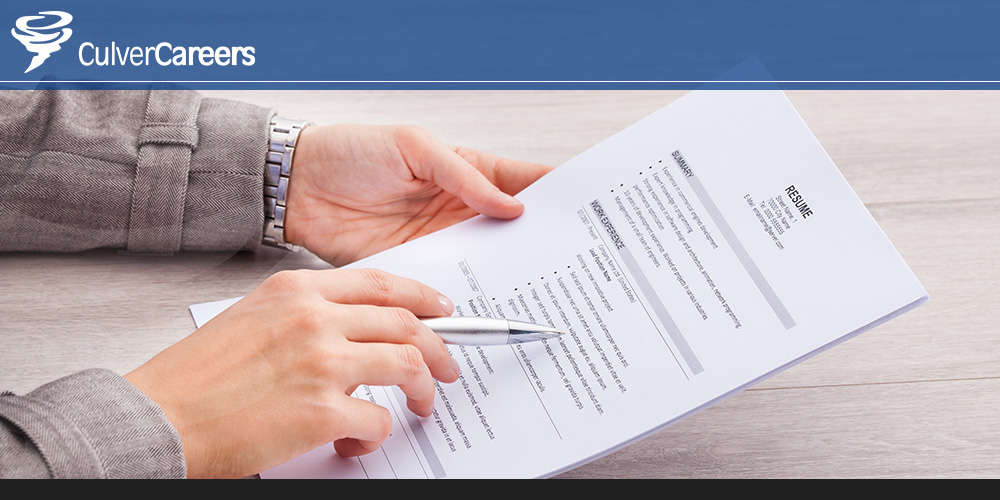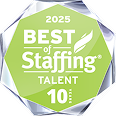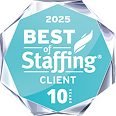Once the long process of recruiting, interviewing, and hiring a new employee has ended, it may seem like the recruiting process is over. However, it is important to look at the employee onboarding process as an extension of the hiring process. An effective onboarding strategy can lead to an employee who feels ready and excited to do their job, while poor onboarding practices can lead to feelings of discontent and ultimately, employee turnover.
Employee onboarding is defined by the Society for Human Resource Management as “the process of helping new hires adjust to social and performance aspects of their new jobs quickly and smoothly.” Note that socialization is included in this definition. Onboarding and training go hand in hand, but onboarding incorporates assimilating the new hire into the company culture, whereas training focuses solely on the performance elements of the new employee’s job. An onboarding process should include HR onboarding, onboarding training, and an onboarding into the culture of your company.
Onboarding new employees effectively is a huge step in the Employee Experience and can lay the groundwork for a positive experience from the new employee’s standpoint. It can set them on a path for success and strong team building.
To cover all of the necessary ground when onboarding new hires, you must do so in an organized manner. Here, we discuss six essential steps to take during a new employee onboarding process.
1. Have a Formal Onboarding Plan in Place
Different types, sizes, and styles of companies handle the formality of the onboarding experience in different ways, but according to SHRM, “research shows that organizations that engage in formal onboarding by implementing step-by-step programs for new employees to teach them what their roles are, what the norms of the company are and how they are to behave are more effective than those who do not.”
There is a lot to balance when building an effective onboarding program. Particularly if the manager in charge of onboarding procedures has separate responsibilities, it’s easy for steps to fall through the cracks if an employee onboarding checklist is not clearly outlined. Additionally, a clear program will help to keep the new hire’s onboarding process on track.
Conventionally, a new employee onboarding process has lasted 90-100 days. The more modern approach is to more efficiently onboard during the first month and set a clear framework for consistent growth and long-term goals throughout the lifespan of the employee’s journey. By focusing on building onboarding tools and procedures in advance, you will set your new employees up for success.
2. Prepare Other Employees for The New Hire’s Arrival
There is nothing like walking into a job on your first day and feeling like no one even knows you’re there. To avoid your new employee feeling unwelcome or unnoticed, actively communicate with your employees regarding the new hire.
Let everyone know who this person is, what job they will be performing, and information about their background and experience. Arrange for your employee to be introduced to everyone they will be working with, at least in an informal manner, in cases where a formal one-on-one isn’t necessary. Perhaps organize a team lunch or a quick “get to know you” session at the end of a morning meeting. This will help both your existing employees to feel included in the process, and your new employee to feel welcomed and to begin to acclimate to the company culture.
3. Provide the Employee with Information in Advance
Communicate with your new employee before their first day. Let them know what to expect when it comes to things like parking, transit, dress code, hours, and so forth. Advise whether they need to bring lunch in their first few days, or if they’ll be having lunch meetings. Anything to ease their transition into the position will make the experience a more pleasurable one, and improve their opinion of the company.
If you can provide some introductory information about the company or things that would be good to know for the position, do so. Your new hire is probably excited to begin the onboarding process, and there’s no reason to delay. Don’t overload them with a million things to do, but providing some training videos or other resources to get started can help them ease into the position.
You can also cut down on time and paper by creating a new employee portal for the typical human resources paperwork usually filled out on the first day. This way, you minimize time spent on paperwork, and can allow more time in case the employee has questions about what they were sent.
4. Be Fully Prepared for Their Arrival
It makes no sense for a new hire to spend half of their day waiting on IT to set up their computer, or for their manager to assign them an email address. Make sure everything they need to get to work is ready to go prior to their first day.
This includes the workstation itself, their email address and phone number, and any software licenses. It is a waste of time and sends the wrong message about the company’s efficiency to have your new hire wait around with nothing to do while these things get set up. Prepare them to succeed from day one!
5. Assign a Coach or Mentor
Assign the new hire a coach or mentor during training time, so not everything falls to the hiring manager. This person can be a peer, or someone in a position slightly senior to the new employee. They should feel comfortable approaching this person with questions at any time. This will ensure that they will not worry about being a nuisance by asking too many questions of a busy manager, but can still get the answers they need.
This person can also serve as your new hire’s company culture and social liaison. A huge part of job satisfaction and employee retention is being able to make friends at work and feeling included, and this onboarding buddy, so to speak, can make sure the new employee doesn’t slip through the social cracks.
6. Have Scheduled, Regular Manager Check-ins
Employee onboarding may officially end at the 30-day mark, but continue to follow up regularly and check on the progress of your employee. Communication should be open, and check-ins should be scheduled in advance and not missed for any reason.
Even if the employee seems to be doing well, this is a good chance to get on the same page make sure things are going according to plan. You can also take these early monthly check-ins as opportunities to get feedback from the new employee on how they felt the onboarding process went, and learn from this for future hires.
Whether you’re onboarding one new employee or many, these steps will help you to ensure the onboarding experience is positive and effective.





